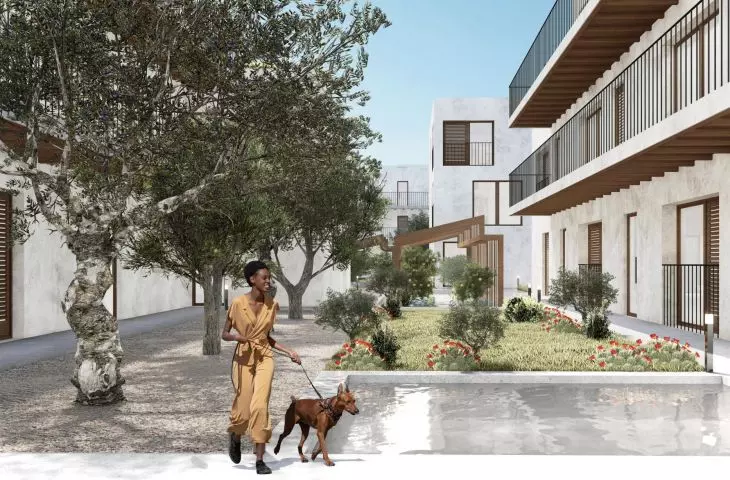Work submitted for the competition
"Best Diploma Architecture"
The subject of the study is the design of a residential complex located in the city of Visalia. The complex is designed for families of agricultural workers, and includes one hundred and five apartments of various sizes. The key issue was to face the difficult climatic conditions and frequent fires.
Visualization of the buildings on the estate
© Dominika Bednarek
The designed buildings have two or three floors above ground and one small underground floor. The basic urban planning decision was to give the buildings the form of mini-quarters. They have a semi-open form, which facilitates ventilation. The wings of the building form an inner courtyard, which is a semi-private zone for tenants. There are greenery, a water reservoir and a greenhouse where residents can grow plants together.
urban schemes
© Dominika Bednarek
The masses of the individual buildings are locally lowered and replaced by a utility terrace to provide better light in all units, as well as to reconstruct the original biologically active area. Two road axes have been routed, dividing the site into three parts. Six quarters were obtained, consisting of three residential modules, combining one-, two- and three-bedroom apartments. At the center of the complex is a community building with recreational areas. It includes, among other things, a sports field, a playground, an outdoor gym and a barbecue meeting place.
landscaping
© Dominika Bednarek
The buildings are adapted to the climatic conditions prevailing in the area of the development site through the use of sustainable architecture solutions. Both natural building materials and advanced eco-friendly systems have been proposed. They reduce the negative effects of harsh weather conditions while taking advantage of their positive aspects. Among others, a passive wall system made of hemp concrete — a very good insulator that eliminates thermal bridges — has been used. Its extremely valuable feature is also its negative carbon footprint — it is the only one of the building materials that tends to absorb excess CO2 from the environment. It is a renewable building material, increasing biodiversity. It is also a non-flammable material, which is very important in this region. Due to the prevailing droughts, maximum use was made of rainwater, the buildings were equipped with rainwater tanks. In addition, shaded water tanks have been designed throughout the estate to store and reuse water, thus improving the microclimate of the surrounding area.
cross section of the complex
© Dominika Bednarek
All quarters have been equipped with a ground source heat pump. According to the state of California's zero-energy building regulations, buildings under construction there must have a positive energy balance. The significant prevalence of sunny days throughout the year and low cloud cover are conducive to acquiring a large amount of solar energy.
solution diagram
© Dominika Bednarek
Accordingly, the buildings are connected to a network of photovoltaic installations, and an innovative perovskite system was used. Transparent cells that transmit the sun's rays and provide good lighting were used, acquiring solar energy at the same time. Calculations were made on the basis of a model building, which show that the adopted solutions allow not only to cover the energy demand, but also to obtain a surplus. The project promotes sustainable design with respect for the environment. It was created on the basis of the analyses carried out and after considering the needs of the residents.
Dominika BEDNAREK
Illustrations: © Author








































